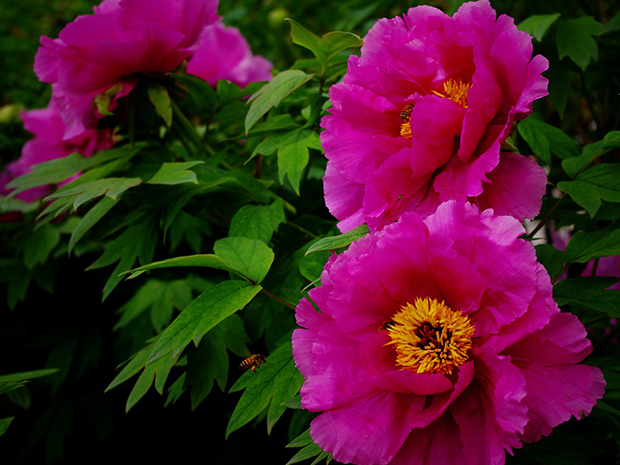Oh, those huge fluffy flowers…there is nothing like them. Peonies must be hard to grow with blooms like those. Not so! Peonies are deliciously easygoing plants as long as you give them a good home. Unlike daylilies, hostas or irises, peonies don’t appreciate being moved once they’ve been planted. Get the site right and you will have a beautiful and reliable flowering plant that is known for its longevity. Some have been known to live for 40 and it’s not uncommon for them to last longer than that!
One characteristic that makes peonies a good choice for our northern gardens is their love of winter. Luckily for us, the cold helps them get ready for bud formation. That means we can have these camellia-like flowers blooming all over the garden without a lot of effort! Before you start growing peonies, you’ll want to know that there are different types.
Here are a few quick descriptions:
Herbaceous Peonies – These peonies are like any other perennial flower in that they die back to the ground before winter and come up again in the spring.
Tree Peonies – Not actually a tree, a tree peony has very strong stems (no staking needed) and behaves more like a shrub. It does not die back to the ground in the winter. The flowers of the tree peony are huge dinner plate sized.
Intersectional or Itoh Peonies – These peonies are a cross between herbaceous and tree peonies, giving them the huge blooms and strong stems of a tree peony, but on a plant that dies back to the ground like an herbaceous peony. Many people also plant peonies with varying bloom times for a longer peony season.
The colors of the peony are clear and perfect. Red, white, yellow, coral and pink in varying shades grace these fragrant flowers. Yes! They are beautifully scented! Blooms will appear in late spring or early summer. The flower forms vary from single to double some with fluffy yellow or white staminodes in the middle.
Planting Tips
Plant peonies in full sun. Many gardeners say a half day of sun will suffice but peonies bloom more profusely in the sun. Making sure your plant gets 6 hours of sun each day is the best way to avoid disappointment.
Peonies not only want well-draining soil they want very rich soil. When planting new peonies it’s advisable to add aged manure or good compost to the existing soil. The pH should be between 6 and 7.
Be sure to plant your peony at the same soil level as it is in the pot it comes out of. This is extremely important if you’re planting an Itoh or intersectional peony. You will see short little stubs called “hairs” at the bottom of the stems at the soil line. If the hairs are buried this spells disaster for your plant.
Yes, you will want to stake your peonies unless it’s a tree peony. The flowers are big and heavy! If you don’t mind the look, bamboo stakes are inexpensive and easy to use. Run some garden twine between the stakes to create a grid that the plants can come up through. Peony rings are another option, made specially for…you guessed it! Peonies! There is no right or wrong. Choose which option is best for you. Stakes can always be cut down close to the height of the stems.
Care
Peonies aren’t fond of being fed too often. Add good rich compost when planting and then each year after new stems begin to appear. Working in some aged manure is a good method of giving nutrients. Some Plant-tone can be worked in at the same time. Be mindful not to cover the plants when amending the soil. Peonies will suffer if given too much fertilizer so once in spring is enough.
Unlike many northern grown plants peonies are not in need of mulching. If you apply mulch in the fall after cutting them down, be sure to remove it in the spring only leaving a very thin layer if any.
During blooming, deadhead the large flowers as they begin to fade. Following the stem down to the next large leaf cut just above the leaf joint.
In the fall, you’ll want to cut peonies down to the ground. This will avoid a threat of disease over the winter unless you have a tree peony.
Ants? They will love your peonies too, but don’t discourage them. They are working hard at fighting insects that will eat peony buds!
How to pronounce peony? Pee-ah-nee or Pee-OH-nee. It’s a regional thing. Both are correct. Some people still call them pineys which is a very sweet common name many of our grandmothers used.

